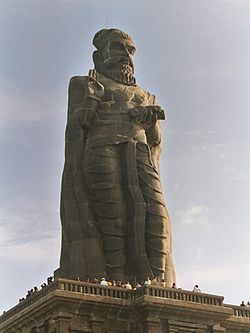Thiruvalluvar
Tamil poet and philosopher

The Thiruvalluvar statue in Kanyakumari
|
|
| Born | Probably between 3rd and 1st centuries BCE; Latest possible date: 31 BCE (as approved by the Government of Tamil Nadu) Possibly at Thirumailai (present-day Mylapore, Chennai) or Thirunainar Kuruchi, Valluvanad (present-day Kanyakumari district) |
| Nationality | Indian |
| Other names | Valluvar, Mudharpaavalar, Deivappulavar, Gnanavettiyaan, Maadhaanupangi, Naanmuganaar, Naayanaar, Poyyirpulavar, Dhevar, Perunaavalar[1] |
| Ethnicity | Tamil |
| Notable work | Tirukkural |
| Religion | Probably Hinduism or Jainism |
| Spouse(s) | Vaasuki |
| Era | Sangam |
| Region | Present-day Tamil Nadu |
Notable ideas
|
Common ethics and morality |
Contents
Traditional accounts
A temple for Thiruvalluvar in Mylapore
He has been said to have been a weaver and the supposed house he lived is now converted to a temple. His wife's name is Vaasuki. There are lots of legends about the pair Thiruvalluvar and Vaasuki. Two of them are: 1) Once Vaasuki Ammaiyar was drawing water from well and Thiruvalluvar called her and she left the water and ran in immediately, but the water pot stayed in mid air. Such was her austerity and dedication towards her husband Thiruvalluvar; 2) Thiruvalluvar used to sit every day for meal with a cup of water and a wooden tooth pick. He did this to pick any grain of rice spilled out from his leaf when Vaasuki Ammaiyar served food. It was said that Thiruvalluvar could not even pick a grain of rice every day. Such was the dedication in serving meal by Vaasuki Ammaiyar. Thiruvalluvar may have spent part of his life in Madurai because it was under the Pandiya rulers that many Tamil poets flourished. There is also the recent claim by Kanyakumari Historical and Cultural Research Centre (KHCRC) that Valluvar was a king who ruled Valluvanadu in the hilly tracts of the Kanyakumari District of Tamil Nadu.[9] [10]
Thirukkural
Main article: Thirukkural
Thiruvalluvar Statue
Other books
Other than the Thirukkuṛaḷ, Thiruvalluvar is alleged to be the author of two Tamil texts on medicine, Gnana Vettiyan and Pancharathnam; although many scholars claim that they were by a later author with the same name,[13] since they appear to have been written in the sixteenth and seventeenth centuries.these books panchae raethnaem and gnana veatiaen contributes to the Tamil,science, literature and other ayur veda medicines[14]Memorials
Main articles: Thiruvalluvar Statue and Valluvar Kottam
Thiruvalluvar statue in SOAS, University of London.
There is a 133-foot tall statue of Thiruvalluvar erected at Kanyakumari at the southern tip of the Indian subcontinent, where the Arabian Sea, the Bay of Bengal, and the Indian Ocean converge. The 133 feet denote Tirukkuṛaḷ's 133 Chapters or athikarams and the show of three fingers denote the three themes Aram, Porul, and Inbam, i.e. the sections on Morals, Wealth and Love. The statue was designed by V. Ganapati Sthapati, a temple architect from Tamil Nadu.[19] His statue was unveiled in Ulsoor, near Bengaluru, on 9 August 2009, also making it the first of its kind for a poet of a local language to be installed in its near states other than his own home land at India. There is also a statue of Thiruvalluvar outside the School of Oriental and African Studies in Russell Square, London.[20]
The government of Tamil Nadu celebrates the 15th (16th On Leap Years) of January as (as Per Tamil Calendar தை-2) Thiruvalluvar Day as part of the Pongal celebrations in his honour.[21]




No comments:
Post a Comment